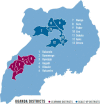Addressing the Second Delay in Saving Mothers, Giving Life Districts in Uganda and Zambia: Reaching Appropriate Maternal Care in a Timely Manner
- PMID: 30867210
- PMCID: PMC6519669
- DOI: 10.9745/GHSP-D-18-00367
Addressing the Second Delay in Saving Mothers, Giving Life Districts in Uganda and Zambia: Reaching Appropriate Maternal Care in a Timely Manner
Abstract
Background: Between June 2011 and December 2016, the Saving Mothers, Giving Life (SMGL) initiative in Uganda and Zambia implemented a comprehensive approach targeting the persistent barriers that impact a woman's decision to seek care (first delay), ability to reach care (second delay), and ability to receive adequate care (third delay). This article addresses how SMGL partners implemented strategies specifically targeting the second delay, including decreasing the distance to facilities capable of managing emergency obstetric and newborn complications, ensuring sufficient numbers of skilled birth attendants, and addressing transportation challenges.
Methods: Both quantitative and qualitative data collected by SMGL implementing partners for the purpose of monitoring and evaluation were used to document the intervention strategies and to describe the change in outputs and outcomes related to the second delay. Quantitative data sources included pregnancy outcome monitoring data in facilities, health facility assessments, and population-based surveys. Qualitative data were derived from population-level verbal autopsy narratives, programmatic reports and SMGL-related publications, and partner-specific evaluations that include focus group discussions and in-depth interviews.
Results: The proportion of deliveries in any health facility or hospital increased from 46% to 67% in Uganda and from 63% to 90% in Zambia between baseline and endline. Distance to health facilities was reduced by increasing the number of health facilities capable of providing basic emergency obstetric and newborn care services in both Uganda and Zambia-a 200% and 167% increase, respectively. Access to facilities improved through integrated transportation and communication services efforts. In Uganda there was a 6% increase in the number of health facilities with communication equipment and a 258% increase in facility deliveries supported by transportation vouchers. In Zambia, there was a 31% increase in health facilities with available transportation, and the renovation and construction of maternity waiting homes resulted in a 69% increase in the number of health facilities with associated maternity waiting homes.
Conclusion: The collective SMGL strategies addressing the second delay resulted in increased access to delivery services as seen by the increase in the proportion of facility deliveries in SMGL districts, improved communication and transportation services, and an increase in the number of facilities with associated maternity waiting homes. Sustaining and improving on these efforts will need to be ongoing to continue to address the second delay in Uganda and Zambia.
© Ngoma et al.
Figures



Similar articles
-
Addressing the First Delay in Saving Mothers, Giving Life Districts in Uganda and Zambia: Approaches and Results for Increasing Demand for Facility Delivery Services.Glob Health Sci Pract. 2019 Mar 13;7(Suppl 1):S48-S67. doi: 10.9745/GHSP-D-18-00343. Print 2019 Mar 11. Glob Health Sci Pract. 2019. PMID: 30867209 Free PMC article.
-
Impact of the Saving Mothers, Giving Life Approach on Decreasing Maternal and Perinatal Deaths in Uganda and Zambia.Glob Health Sci Pract. 2019 Mar 13;7(Suppl 1):S27-S47. doi: 10.9745/GHSP-D-18-00428. Print 2019 Mar 11. Glob Health Sci Pract. 2019. PMID: 30867208 Free PMC article.
-
Addressing the Third Delay in Saving Mothers, Giving Life Districts in Uganda and Zambia: Ensuring Adequate and Appropriate Facility-Based Maternal and Perinatal Health Care.Glob Health Sci Pract. 2019 Mar 13;7(Suppl 1):S85-S103. doi: 10.9745/GHSP-D-18-00272. Print 2019 Mar 11. Glob Health Sci Pract. 2019. PMID: 30867211 Free PMC article.
-
The untold story: how the health care systems in developing countries contribute to maternal mortality.Int J Health Serv. 1992;22(3):513-28. doi: 10.2190/91YH-A52T-AFBB-1LEA. Int J Health Serv. 1992. PMID: 1644513 Review.
-
Safety versus accessibility in maternal and perinatal care.S Afr Med J. 2015 Apr;105(4):261-5. doi: 10.7196/samj.9182. S Afr Med J. 2015. PMID: 26294862 Review.
Cited by
-
What the percentage of births in facilities does not measure: readiness for emergency obstetric care and referral in Senegal.BMJ Glob Health. 2020 Mar 3;5(3):e001915. doi: 10.1136/bmjgh-2019-001915. eCollection 2020. BMJ Glob Health. 2020. PMID: 32201621 Free PMC article.
-
Translating lessons to reinforce national stillbirth response; multi-stakeholder perspectives regarding priorities and opportunities to deliver quality evidence-based interventions within a limited-resource context in Uganda.BMC Health Serv Res. 2024 Jun 10;24(1):715. doi: 10.1186/s12913-024-11180-z. BMC Health Serv Res. 2024. PMID: 38858756 Free PMC article.
-
Continuum of maternity care in Zambia: a national representative survey.BMC Pregnancy Childbirth. 2021 Sep 5;21(1):604. doi: 10.1186/s12884-021-04080-1. BMC Pregnancy Childbirth. 2021. PMID: 34482830 Free PMC article.
-
Quality and women's satisfaction with maternal referral practices in sub-Saharan African low and lower-middle income countries: a systematic review.BMC Pregnancy Childbirth. 2020 Nov 11;20(1):682. doi: 10.1186/s12884-020-03339-3. BMC Pregnancy Childbirth. 2020. PMID: 33176732 Free PMC article.
-
Cervical cancer diagnosis and treatment delays in the developing world: Evidence from a hospital-based study in Zambia.Gynecol Oncol Rep. 2021 May 13;37:100784. doi: 10.1016/j.gore.2021.100784. eCollection 2021 Aug. Gynecol Oncol Rep. 2021. PMID: 34095422 Free PMC article.
References
-
- World Health Organization (WHO), United Nations Children's Fund, United Nations Population Fund, World Bank Group, and the United Nations Population Division. Trends in Maternal Mortality: 1990 to 2015. Geneva: WHO; 2015. https://www.who.int/reproductivehealth/publications/monitoring/maternal-... Accessed December 3, 2018.
-
- World Health Organization (WHO), United Nations Population Fund, United Nations Children's Fund, and Columbia University Mailman School of Public Health. Monitoring Emergency Obstetric Care: A Handbook. Geneva: WHO; 2009. http://www.who.int/reproductivehealth/publications/monitoring/9789241547... Accessed December 3, 2018.
-
- Holmes W, Kennedy E. Reaching emergency obstetric care: overcoming the ‘second delay.’ Melbourne: Burnet Institute on behalf of Compass, the Women's and Children's Health Knowledge Hub; 2010. http://www.transaid.org/wp-content/uploads/2015/06/Reaching-emergency-ob... Accessed May 3, 2018.
MeSH terms
LinkOut - more resources
Full Text Sources
